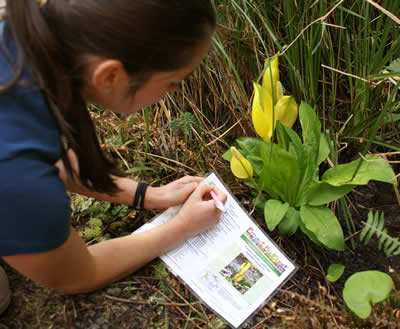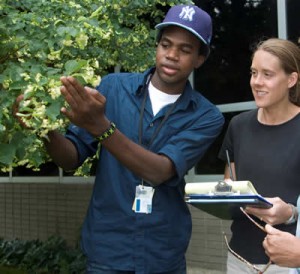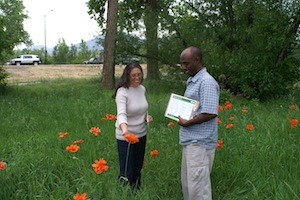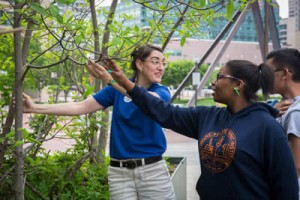
A volunteer at Lewis and Clark National Historical Park makes an observation of skunk cabbage. Photo credit: Lewis and Clark National Historical Park.

A volunteer at Lewis and Clark National Historical Park makes an observation of skunk cabbage. Photo credit: Lewis and Clark National Historical Park.
Everyone knows that many flowers come out in spring and most leaves turn color in autumn. Even small children take delight in the seasonal cycles of plants.
But the timing of seasonal cycles is changing. Scientists have observed earlier blooming and later leaf fall in many plant species due to global warming. As global temperatures rise, plant cycles are changing in response.
What scientists don’t know is exactly how or where the cycles are changing — or how fast the changes are happening. Hiring researchers to track the changes across the nation would be impossible.
That’s where citizen science can help. In 2007, climate change researchers decided to engage volunteers in collecting data on seasonal changes in plants. Sponsored by the National Science Foundation and run by the National Ecological Observatory Network in partnership with the Chicago Botanic Garden, Project BudBurst is now a flourishing network of volunteers across the United States who monitor plants for seasonal changes.
Download this case study (PDF, 147KB)
Website: Project BudBurst

Project BudBurst volunteers make observations of a tree. Photo credit: Carlye Calvin, University Center for Atmospheric Research.
Volunteers begin by creating an account on the Project BudBurst website. Next, they get online training in what to look for as they monitor plants. They choose a particular plant to monitor, such as a tree in their own backyard. Then they use a standard monitoring form to describe the plant’s location and to observe seasonal changes — changes that range from leafing, to flowering, to fruiting, to the timing of fall color and leaf fall. Finally, they report their observations on an online database.
Project BudBurst has thousands of volunteers in all 50 states, with participants tracking more than 250 plant species. The volunteers can track any plant they choose, but project organizers encourage them to choose from among 10 plants in particular. The “top ten” are easily identifiable, widely distributed and scientifically interesting. They include species such as California poppy, red maple, forsythia and Virginia bluebell.

Project BudBurst volunteers making an observation of local wildflowers. Photo credit: NEON, Inc.
Project BudBurst resources are entirely Web-based, making them easy to access wherever Internet connections are available. However, the ability to participate using mobile devices is limited to a simplified HTML5 interface rather than a dedicated mobile app for offline usage. Efforts are underway to develop a dedicated mobile app so that volunteers can report data in areas without strong cell phone signals, such as in rural areas or in remote field locations.
People are familiar with changing weather patterns from day to day or week to week, but changing climate patterns happen on much longer time scales — decades. The scientific value of Project BudBurst is in long-term data collection, but people often want much more immediate responses. “What have we learned from a few years of data observations?” is a question often asked of program managers at Project BudBurst. As with most citizen science programs, recruitment and retention of volunteers is always a challenge.

Visitors at the National Aquarium learn about plants. Photo credit: National Aquarium.
Through Project BudBurst, citizen scientists are collecting valuable information about seasonal plant cycles in a consistent way across the country. Scientists use the data to learn more about the responsiveness of individual plant species to changes in climate locally, regionally and nationally. By comparing the results to historical data, researchers can detect some of the long-term impacts of climate change, and data from Project BudBurst are already going into scientific studies across the country.
In addition, Project BudBurst provides opportunities for volunteers and others to learn how plants are changing in response to changing environmental conditions. The project’s website has lots of information on the seasonal cycles of plants, how they have been studied and how they have changed over time. Project BudBurst educational materials are highly regarded by educators in both formal and informal settings. Online professional development courses for using Project BudBurst in various educational settings are available through NEON’s Citizen Science Academy.
The Project Budburst case study illustrates the following steps in the Federal Citizen Science and Crowdsourcing Toolkit:
Elizabeth Blood
Email: eblood@nsf.gov
Sandra Henderson
Email: shenderson@neoninc.org